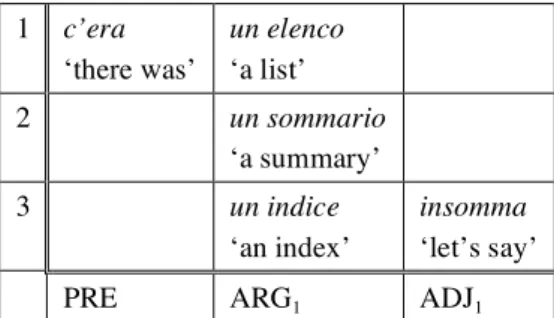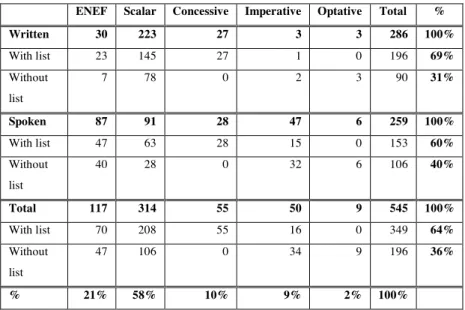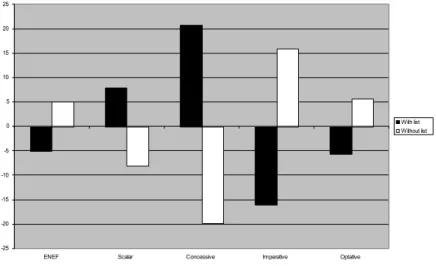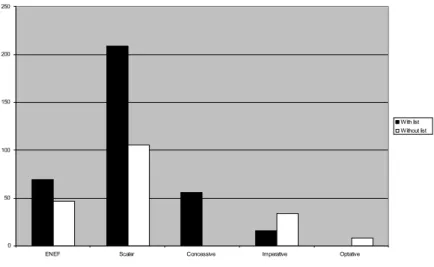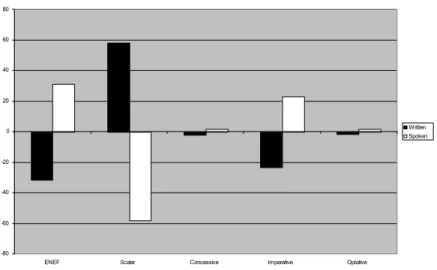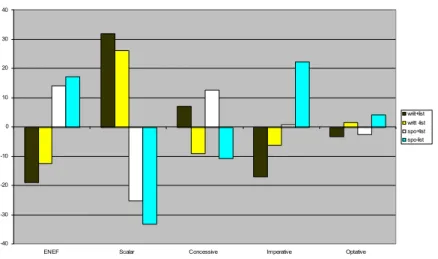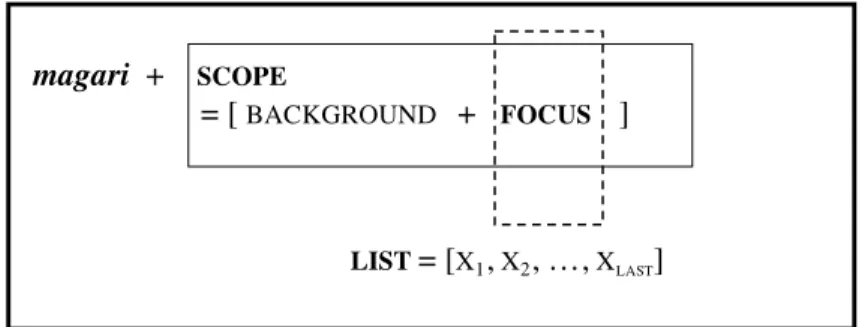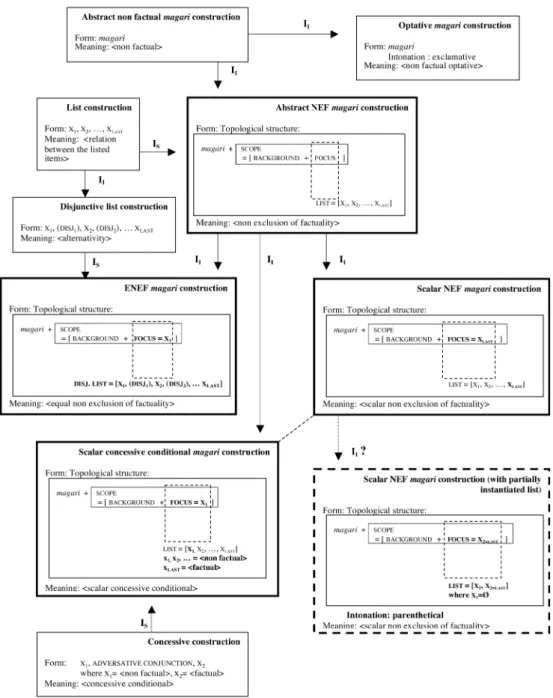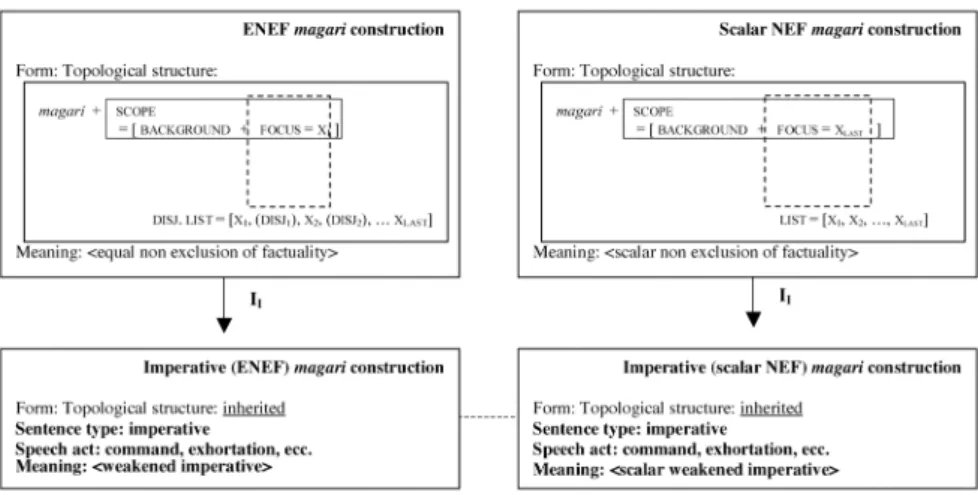HAL Id: hal-00664070
https://hal.archives-ouvertes.fr/hal-00664070
Submitted on 28 Jan 2012
HAL is a multi-disciplinary open access archive for the deposit and dissemination of sci- entific research documents, whether they are pub- lished or not. The documents may come from teaching and research institutions in France or abroad, or from public or private research centers.
L’archive ouverte pluridisciplinaire HAL, est destinée au dépôt et à la diffusion de documents scientifiques de niveau recherche, publiés ou non, émanant des établissements d’enseignement et de recherche français ou étrangers, des laboratoires publics ou privés.
To cite this version:
Francesca Masini, Paola Pietrandrea. Magari. Cognitive Linguistics, De Gruyter, 2010, 21 (1), pp.75- 121. �hal-00664070�
Magari
∗FRANCESCA MASINI and PAOLA PIETRANDREA
Abstract
We propose a constructionist approach to the polyfunctionality of the Italian focus particle magari (roughly corresponding to
‘maybe’, but also ‘I wish’). The sheer syntactic versatility of this word leads us to detect its formal regularities at the level of discourse configurations. This level of analysis, identified within the French linguistic tradition, is defined by the maintenance of a predicate-argument-adjunct structure in discourse. The salient feature of discourse configurations is their shape, which can be described by referring to a number of topological patterns: lists of elements in the same syntactic position, repetition of syntactic structures, shifting of elements from a post-verbal to a pre-verbal position and so on. These topological patterns are meaningful to an extent and they are eligible to be regarded as constructions.
Magari is shown to be regularly associated with a general topological pattern, namely a list of items that occupy the same syntactic position as the item focused by magari. Each semantic function of magari correlates with one particular kind of list. These associations of a form (the different types of lists) and a meaning (the functions of magari) are shown to be related to one another by means of inheritance links.
Keywords: non factuality, focus particle, construction grammar, discourse configuration, topology, lists.
1. The polyfunctionality of magari
The word magari has attracted considerable attention among Italian linguists because of its especially intriguing polyfunctionality that knows no parallel in its counterparts in other European languages (cf. Arcaini 1997, 2000; Licari and Stame 1989; Schiemann 2008).
Firstly, magari can have the function of a general marker of non factuality. In this case, it roughly corresponds to the English adverb
‘maybe’. See example (1):
(1) Magari è a casa
‘Maybe (s)he is at home’
Magari can also function as a scalar operator (in the sense of Fillmore, Kay and O’Connor 1988 and Kay 1990), triggering a scale of non factuality whose extreme position is occupied by the constituent in the focus of magari. See (2):
(2) Bisognerebbe negoziare una tregua, un armistizio, magari la pace
‘It would be necessary to negotiate a ceasefire, an armistice and maybe peace’
Besides, magari may act as a non factual concessive marker, as in (3), where the speaker concedes that the subject is clever despite thinking that he has not studied enough:
(3) Magari è intelligente, ma non è abbastanza preparato
‘He might be clever, but he has not studied enough’
In imperatival contexts, magari weakens the illocutionary force of the order, as in the following example:
(4) Magari parlagliene tu!
‘Perhaps you yourself could talk to him about it!’
Finally, magari functions as an optative marker. This happens when it occurs in exclamative contexts:
(5) Vorrei tanto vedere un film come quello. Magari ne facessero ancora!
‘I really would like to watch a movie like that. I wish they still made some!’
(6) A: Vuoi un po’ di riposo?
‘Would you like to rest a bit?’
B: Magari!
‘I’d love to! / I wish I could!’
2. The problem
The problem that arises is: how can we account for the polyfunctionality of magari? First of all, one should decide whether the functions of magari are somewhat related to each other or are completely independent, i.e. homonymous. There is a good reason for rejecting the latter hypothesis, namely: the set of functions held by magari—non factual, scalar non factual, non factual concessive, imperative, optative—recalls in most respects the semantic network developed by several irrealis markers of non factuality in various non-European languages (cf., e.g., Elliott 2000; Lazard 1998). The crosslinguistic presence of similar semantic networks makes it fairly unlikely that we are dealing with pure homonymy.
We therefore consider the various functions of magari as microsenses of this word, that is “distinct sense units […] that occur in different contexts and whose default construals stand in a relation of mutual incompatibility at the same hierarchical level”
(Croft and Cruse 2004: 126–7). Under this perspective, the word magari has a hyperonymic reading and a cluster of hyponymous readings, whose default construals are sister incompatibles (Croft and Cruse 2004: 127).
The question now arises of identifying the contexts that licence the various functions of magari and the nature of the relations holding between these functions. Such a task is made more complicated by the sheer syntactic versatility of magari. Indeed the contexts in which magari occurs can be properly detected only by adopting a wide-ranging notion of context. In section 3 we describe the practical difficulties encountered in the analysis of magari and the theoretical approach and tools adopted for solving them, whereas in section 4 we provide a qualitative and quantitative description of magari and its various functions. In section 5, we give a construction grammar account of our findings.
3. The theoretical approach 3.1. Construction grammar
A fruitful theoretical approach to the kind of problem outlined in the previous section is to place the analysis of magari in the wide framework of construction grammar. As is well known, construction grammar comprises a number of different models (cf., among others, Croft 2001; Fillmore, Kay and O’Connor 1988;
Goldberg 1995, 2006; Kay and Fillmore 1999), which nevertheless share a set of basic tenets. The main tenet regards the very notion
of “construction”, which is defined as a conventionalized association of a form and a meaning and is considered the basic unit of linguistic analysis. This definition virtually captures every meaningful unit of language, ranging from simple words to more complex and abstract sentence-level structures, such as argument structure constructions (Goldberg 1995) or sentence types (Michaelis and Lambrecht 1996). It is thus clear that certain higher-level abstract patterns, those that are commonly considered as “context” for lower-level lexically specified units, may be treated as full linguistic objects in this framework, provided that they prove to be meaningful to some extent.
Another assumption of constructionist approaches that is crucial for our purposes is that they take into account “not only syntactic and semantic information, but also lexical and/or pragmatic information” (Kay 1990: 61) and that all this information is coded simultaneously in the construction and contributes to characterize the constructions itself.
This provides the tools for the detection of the correlations between certain contexts, or rather “constructions”, and the various functions of magari. This latter theoretical issue has been recently addressed by Fried (2007), who has convincingly argued that the relations between the different functions of the same polyfunctional lexical unit are better understood if one takes into account the entire construction in which they occur, rather than the single item under examination. Therefore, the entire construction becomes the true linguistic form to be investigated.
Still another aspect of constructionist approaches—and in particular of Goldberg’s “cognitive construction grammar”
(Goldberg 2006)—that will prove useful in our analysis is the use of inheritance links, which account for the relations holding among constructions. The inheritance system works this way: if construction A shares some formal properties with construction B, then construction A also shares some semantic properties with B, and the two constructions are related by an inheritance link. As is well known, according to Goldberg (1995: 75ff), there are four major types of inheritance links: polysemy links (IP), subpart links (IS), instance links (II) and finally metaphorical extension links (IM).1 Given this framework, all the possible abstract constructions that host the adverb magari can be regarded as constructions that share at least one formal property—namely the presence of magari—and that are eligible to be linked to one another at the representational level. Therefore, once we have identified the form
of the constructions in which magari occurs, we will have to determine which kind of inheritance links connect these various constructions to one another. First of all, though, we have to address the formal analysis of the contexts of magari, which is not unproblematic.
3.2. A practical difficulty
A practical difficulty in the formal analysis of magari concerns the above-mentioned syntactic versatility of this word, which makes it particularly hard to define its contexts of occurrence.
Indeed, magari occurs in every illocutionary act: assertions (cf.
examples (1) to (3)), orders (4), exclamations (5). It can also occur in questions, as exemplified in (7):2
(7) Non potrebbe essere uscito con un amico? Non sarà magari con suo fratello?
‘Don’t you think he might have gone out with a friend?
Couldn’t he be with his brother?’
What is more, the categorial status of magari is not easy to define: it can be used either as an interjection (6) or as an adverb (cf. examples (1) through (5) and (7)). Occasionally, and retaining some of the semantic properties of its adverbial function, it can also be understood as a clause connective, as exemplified in (8):
(8) Magari un po’ debolina, magari me la sono immaginata, magari è solo un effetto ottico… Ma vi giuro che l’ho vista [Web]
‘Maybe a bit feeble, maybe I dreamt it, maybe it’s just an optical effect, but I swear I saw it’
As an adverb, magari can have scope on units of different size and category. First, it can have both a clausal scope, as in (1), (3), (4) and (5), and a phrasal scope, as in examples (2), (7) and (9) to (11):
(9) È un piacere venir qui e vedere tutta questa gente che si commuove per me e che magari ha pianto per la mia vittoria [Web]
‘It’s nice to come here and see all these people who are moved because of me and who, maybe, cried for my victory’
(10) Gli aerei piccoli e molto utilizzati, con personale poco pagato e magari stanco, non possono dare la massima tranquillità
né agli utenti né ai sindacati [Web]
‘Small and thoroughly exploited aircrafts, with a badly paid and possibly tired staff, cannot fully reassure either users or trade unions’
(11) Si discute magari male, ma sempre molto a lungo
‘We discuss perhaps badly, but always at great length’
When magari has scope on a phrase, the latter can be a verb phrase (9), an adjectival phrase (10), an adverbial phrase (11), a prepositional phrase (7) and even a noun phrase as in (2). Besides, magari is endowed with an almost unrestrained syntactic mobility:
it can occur in fact at every major phrasal boundary. For example, if we consider the proposition in (12), we may have the patterns in (13):
(12) Luigi è venuto
‘Luigi has come’
(13) a. Magari Luigi è venuto b. Luigi magari è venuto c. Luigi è venuto, magari
Some regularities can be easily detected even in such a complex picture. For example, magari’s use as an optative is preferably expressed with an interjection in exclamative contexts. The imperative use is associated with orders.
Nevertheless, some difficulties remain in detecting the relevant context associated with non factual, scalar and concessive uses of magari. The assertive context, for example, appears to be associated with all these functions. The size and category of the unit within the scope of magari is not a relevant factor in determining the function of this word. As a matter of example, we have shown above that magari retains the same scalar function whether it has scope on a verb phrase (9), an adjectival phrase (10) or a nominal phrase (2). Such a function is also compatible with a clausal scope of magari, as shown in (14):
(14) Forse è venuto ieri, ha passato qui tutto il pomeriggio e magari si è fermato a dormire
‘Perhaps he came yesterday, he spent the whole afternoon here and possibly he stopped for the night’
Not even the distribution of magari within the clause seems to be a relevant parameter to detect its correct function. For instance, when it has a sentential scope, magari may have the same
concessive function whether it fronts the clause (15), is pre-verbal (16) or, finally, post-verbal (17):
(15) Magari Luigi ha sbagliato, ma io non me ne sono accorta
‘Luigi might have made a mistake, but I couldn’t spot it’
(16) Luigi magari ha sbagliato, ma io non me ne sono accorta (17) Luigi ha sbagliato, magari, ma io non me ne sono accorta
This syntactic versatility of magari makes it not trivial to identify the structural constraints that characterize the maximally abstract magari construction (the “hyperonymic” magari) and all other sub- constructions. As things stand, we could simply propose that, in all its functions, magari can be described as the only lexically specified part of a maximally abstract construction in which the only relevant information regards the internal make-up, i.e. the presence of the unit magari with its phonetic properties (even the information about its categorial status is underspecified, since it may behave both as an adverb and as an interjection). Such a characterization is obviously largely unsatisfactory for our purposes.
3.3. Theoretical tools: discourse configurations, topological structures, topological patterns
The difficulty described in the previous section has led us to look for tools that could help in better defining the trans-categorial and trans-level nature of magari. Within the French linguistic tradition, a level of analysis has been identified that is called configuration de discours (‘discourse configuration’) (cf., among others, Blanche-Benveniste 1993, 1997; Blanche-Benveniste et al. 1979, 1990; Gerdes and Kahane in prep.). In order to define discourse configurations, we assume as a primitive what Blanche-Benveniste et al. (1979) called construction maximale (‘maximal construction’), i.e., the predicate-argument-adjunct structure. The predicate-argument-adjunct structure is hardly ever realized together in a sequence in discourse. More frequently, it is gradually built by means of repetitions, rewordings, additions, and other kinds of insistences on one or more of its positions. So, for example, the predicate-argument-adjunct structure in (18) may be realized as in (19) as well as in (20):3
(18) ADJ1-ARG1-PRE-ARG2
(19) Forse chissà io ho scelto il momento sbagliato
‘Maybe, who knows, I have chosen the wrong moment’
1 forse
‘maybe’
2 chissà
‘who knows’
io
‘I’
ho scelto
‘have chosen’
il momento sbagliato
‘the wrong moment’
ADJ1 ARG1 PRE ARG2
(20) Magari lui rincorre un sogno, un’utopia, un ideale qualunque
‘Maybe he pursues a dream, a utopia, an ideal whatsoever’
1 magari
‘maybe’
lui
‘he’
rincorre
‘pursues’
un sogno
‘a dream’
2 un’utopia
‘a utopia’
3 un ideale qualunque
‘an ideal whatsoever’
ADJ1 ARG1 PRE ARG2
A given predicate-argument-adjunct structure can also be instantiated more than once in discourse. For example, the spoken sequence in (21) features two repetitions of the ADJ1-ARG1-PRE- ARG2 structure, beside the multiple instantiations of the ARG1 and ARG2 positions:
(21) praticamente per ogni tipo di gioco c’era un edificio specifico.
Per esempio il circo serviva alle corse dei carri, l’anfiteatro alle lotte dei gladiatori, lo stadio per i giochi atletici
‘In practice, for every kind of game there was a specific building. For example the circus was for the chariot races, the amphitheatre for the gladiator fights, the stadium for athletic
games’ [from Bonvino 2005: 61]
1 praticamente
‘in practice’
per ogni tipo di gioco
‘for every kind of game’
c’era
‘there was’
un edificio specifico
‘a specific building’
2 per esempio
‘for example’
il circo
‘the circus’
serviva
‘was’
alle corse dei carri
‘for the chariot races’
3 l’anfiteatro
‘the amphitheatre’
alle lotte dei gladiatori
‘for the gladiator fights’
4 lo stadio
‘the stadium’
per i giochi atletici
‘for athletic games’
ADJ1 ARG1 PRE ARG2
The chunk made up of the sequence of units “that instantiate or repeat a given predicate-argument-adjunct structure” is called discourse configuration (Pietrandrea 2008a).
As this definition makes clear, discourse configurations are objects defined in purely syntactic terms. Interestingly, though, they may have a semantic investment. Let us consider the following example:
(22) Io mangio. Il mondo crolla
‘I eat. The world collapses’
In this case there is a discourse configuration defined by one repetition of the syntactic structure ARG-PRE. The two sentences making up the discourse configuration depict totally unrelated situations. Still, the syntactic parallelism between the two sentences forces the addressee to find a semantic relation between them: in this case a relation of contrast. Interestingly, when the same situations are depicted by two contiguous but distinct structures, which hence do not form a proper discourse configuration, the addressee is not invited to postulate a relation between the two situations:
(23) ??Sono io che mangio. Il mondo crolla
??‘It is me who eat. The world collapses’
Discourse configurations can be more or less extended: while the discourse configurations in (19) and (20) are limited to a clause, the discourse configuration in (21) spans an entire text.
Therefore, crucially, discourse configurations are defined regardless of the boundary between the clausal and the supra- clausal level.
The discourse configurations from (19) through (25) are represented in “grids”, i.e., through a rewriting procedure elaborated mainly by Blanche-Benveniste and colleagues (1979), Bilger (1982), Blanche-Benveniste and colleagues (1990), Bilger and colleagues (1997), and Bonvino (2005) and Pietrandrea (2008a) for Italian. This rewriting procedure consists in a representation of the speech flow on a bi-dimensional plane and is constrained by three rules: (i) the horizontal axis of the plane should feature the sequence of the positions that define the predicate-argument-adjunct structure; (ii) the vertical axis should list all the actual realizations within each position; (iii) a left-to-
right and top-down reading of the string contained in the grid should render the linear order of the represented chunk.
This representation highlights an important fact, namely that the salient feature of discourse configurations is their shape and not the categories they are made up of. We refer to the shape of a discourse configuration with the term “topological structure”.
Such a topological structure can be described by referring to a number of bi-dimensional “topological patterns”: lists of elements in the same position, repetitions of syntactic structures, chiasms of elements shifting from a pre-verbal to a post-verbal position (or viceversa) and so on.4
It should be noted that units belonging to different levels and categories may enter the same topological structure. For example, the two discourse configurations used as answers in (24) and (25) are made up of clauses and nominal constituents respectively.
Nevertheless, they present the very same topological structure, characterized by a list of instantiations of the rightmost position, whose last element is preceded by magari (cf. section 4.4 for more details on this structure).
(24) A: Come mai è così tranquillo?
‘Why is he so calm?’
B: Sarà rientrato presto, si sarà riposato, magari avrà dormito
‘He probably came back home early, rested, maybe slept’
1 sarà rientrato presto
‘he probably came back home early’
2 si sarà riposato
‘he probably rested’
3 magari
‘maybe’
avrà dormito
‘he probably slept’
ADJ1 PRE
(25) A: Chi può essere stato?
‘Who could have done this?’
B: Un gatto, un cane, magari una scimmietta
‘A cat, a dog, possibly a small monkey’
1 un gatto
‘a cat’
2 un cane
‘a dog’
3 magari
‘maybe’
una scimmietta
‘a small monkey’
ADJ1 ARG1
The body of research carried out on discourse configurations has shown, albeit incidentally, that certain topological patterns, as well as the various topological structures within which those patterns are unified, may have very abstract meanings. For example, we have seen above in (22) that the repetition of the same syntactic structure may carry a meaning of contrast (see also Blanche Benveniste 1997: 113). Another example of “meaningful”
topological pattern comes from the listing of elements in only one position of the grid. The abstract topological pattern “list” has the very general meaning of “relation among the conjuncts” and may assume more specific meanings according to the exact way in which it is instantiated. For instance, it is acknowledged that a list instantiated by conjuncts preceded by one or more additive particles, is interpreted as an additive list (26).
(26) Ha comprato il pane e il latte
‘(S)he bought bread and milk’
1 ha comprato
‘(s)he bought’
il pane
‘bread’
2 e
‘and’
il latte
‘milk’
PRE ADJ1 ARG1
Accordingly, a list instantiated by conjuncts preceded by one or more exclusive particles is interpreted as an exclusive list (27).
(27) Torna domani o dopodomani
‘(S)he will come back tomorrow or the day after’
1 torna
‘(s)he comes back’
domani
‘tomorrow’
2 o
‘or’
dopodomani
‘the day after’
PRE ADJ1 ADJ2
Yet other types of lists are possible (cf. Bonvino and Masini 2007 for a preliminary study, but also Gerdes and Kahane in prep.).
A list which features the repetition (for two, three or more times) of the same lexical material in the same position conveys a general meaning of intensification that, we may suppose, specialises according to the categorial nature of the repeated constituent. For example, the repetition of the adjective piccola ‘small’ in (28) acts as a superlative, while the repetition of the verb in (29), as noted by Bertinetto (1991: 50), is a special way to express continuous aspect in Italian.
(28) Ho visto una casa piccola piccola
‘I saw a little little house’
1 ho visto
‘I saw’
una casa
‘a house’
piccola
‘little’
2 piccola
‘little’
PRE ARG1 ADJ1
(29) L’eroe cerca cerca cerca ma non trova nulla
‘The hero searches, searches, searches but does not find
anything’ [from Bertinetto 1991: 50]
1 l’eroe
‘the hero’
cerca
‘searches’
2 cerca
‘searches’
3 cerca
‘searches’
4 ma
‘but’
non
‘not’
trova
‘finds’
niente
‘anything’
ADJ1 PRE ARG1
ADJ1 ARG1 PRE ARG2
A list which features the repetition of semantically related elements, especially co-hyponyms may convey a meaning of lexical approximation (30).
(30) C’era un elenco, un sommario, un indice insomma
‘There was a list, a summary, an index let’s say’
1 c’era
‘there was’
un elenco
‘a list’
2 un sommario
‘a summary’
3 un indice
‘an index’
insomma
‘let’s say’
PRE ARG1 ADJ1
We propose in Figure 1 a tentative representation of the relations observed between the listing phenomena mentioned above. Albeit preliminary, this representation shows that the use of a topological methodology allows to provide a unified account for a number of constructional phenomena usually treated under different domains.
Figure 1. The constructional network for “lists”
To sum up, topological patterns can be viewed as indefinitely extended, bi-dimensional, syntactic patterns, defined regardless of the boundary between the clausal and the supra-clausal level and (at least at the most abstract level) regardless of the categories they are made up of. These formal patterns are “meaningful” to a certain extent.
3.4. Topological patterns as constructions
The existence of “meaningful” abstract patterns naturally recalls the notion of “construction” in construction grammar. We would propose therefore to consider topological patterns as a type of constructions that operate at the level of discourse configurations.
Including topological patterns among the array of constructions is in line with some important recent attempts to break the boundary of the clause/sentence (Mithun 2005, 2008) and to extend the notion of construction to upper-level entities (Fried and Östman 2004; Fried and Östman 2005; Östman 2005). In fact, as made clear by Fried and Östman (2005) and Östman (2005), construction grammar, as a theory, has no built-in limitation with respect to the extension of the notion of construction to larger stretches of discourse. Yet, only a very limited number of works on constructions deal with upper-level entities. Among them, Östman (2005) should be mentioned, who suggests that constructions can be detected at the textual level, claiming that there exist “discourse patterns” with a form (i.e. text type) and a meaning or function (i.e. genre).
Our paper follows this line of research. However, whereas Östman (2005) extends the notion of construction to entire texts and claims that this textual setting is essential for interpreting certain sentences correctly, in this paper we hypothesize that there exist constructions insensitive to the boundary of the clause/sentence and defined by their topological structure. Like all constructions, they can be more or less specified and enter inheritance systems.
The analysis of magari in what follows will be driven by these theoretical hypotheses.
4. The analysis of magari
Pietrandrea (2007) has—albeit cursorily—observed that, although distributional regularities cannot be found at the clause level, magari has a regular topological distribution in discourse configurations. In particular, she noted that 42 out of the 75 tokens of magari occurring in a small corpus of the Roman variety of
spoken Italian (about 56 percent), are associated with a specific kind of topological pattern: the focus of magari belongs to a list of items that realize the same syntactic position. In utterance (31), for example, the ARG2 position is realized by four different arguments (‘in a scene’, ‘in a forest’, ‘in a jungle’, ‘in the desert’), the first of which is in the focus of magari.
(31) Che ne so poteva comparire una scenografia che che magari li riportava ne in un ambiente, in una foresta piuttosto che in
una giungla nel deserto [LIP]
‘I don’t know a set could appear that that maybe reconveyed them in in a scene, in a forest rather than in a jungle, in the desert’
1 che ne so
‘I don’t know’
poteva comparire
‘could appear’
una scenografia
‘a set’
che
‘that’
2 che
‘that’
magari
‘maybe’
li riportava
‘reconveyed them’
ne
‘in’
3 in un ambiente
‘in a scene’
4 in una foresta
‘in a forest’
5 piuttosto che
‘rather than’
in una giunga
‘in a jungle’
6 nel deserto
‘in the desert’
ARG1 ADJ1 PRE ARG2
ADJ1 PRE ARG1 ADJ2
This strong tendency to occur in lists induced Pietrandrea (2007) to semantically characterize magari, commonly understood as an epistemic adverb, as a generic marker of non factuality, more precisely as a marker of “non exclusion of factuality” (NEF). In other words, putting forward the constituent in the focus of magari as but one of a set of possible options, the speaker does not fully subscribe to the factuality of the proposition realized through that constituent (‘that reconveyed them in a scene’): (s)he simply does not exclude that that proposition could be factual.
We have further extended Pietrandrea’s analysis with the aid of two large, diatopically balanced corpora of both spoken and written contemporary Italian, namely: the la Repubblica corpus (written, approx. 380 million tokens, cf. Baroni et al. 2004) and the Lessico di Frequenza dell’Italiano Parlato (LIP) corpus (spoken, approx.
500.000 tokens, cf. De Mauro et al. 1993).
We randomly selected 600 occurrences of magari (300 in the written corpus and 300 in the spoken corpus). For the sake of consistency, we subtracted from this first corpus 35 occurrences (32 spoken and 3 written) that could not be easily interpreted, such as for example (32), where the speaker interrupts himself right after uttering magari, thus making a proper classification impossible:
(32) Cioè non vorrei scartare questa possibilità a priori insomma magari
‘I mean I wouldn’t want to rule this out from the outset, I mean, magari’
We analyzed the remaining 565 occurrences of magari within the context of their discourse configurations; i.e., we took as a relevant unit of analysis the whole chunk made up of the sequence of units that instantiate or repeat the predicate-argument-adjunct structure that each occurrence of magari contributes to define.
A first thorough analysis of this corpus allowed us to identify the five main functions of magari mentioned in section 1.
Afterwards, both authors coded separately the entire data set. The more problematic cases were discussed together.
This led to exclude, for the sake of simplicity, the 20 occurrences of magari (9 spoken and 11 written) that fulfilled more than one function. Thus, for example, we excluded occurrences such as (33), where magari functions at the same time as a concessive and as a scalar marker.5 The final corpus therefore amounts to a total of 545 (286 written and 259 spoken) occurrences of magari.
(33) Ce la mettono tutta, magari scrivono anche bei pezzi, ma sono troppo limitati, possono esprimersi solo parzialmente [laR]
‘They try hard, they might even write nice pieces, but they are too limited, they can only partially express themselves’
The discussion of the more problematic cases also led to a more precise semantic characterization of the five functions associated to magari, which can be defined as follows:
• equipotential non exclusion of factuality (ENEF);
• scalar non exclusion of factuality;
• scalar concessive conditional;
• weakened imperative;
• optative.
The quantitative results of our investigation on the final sample are given in Table 1.
Table 1. Functions of magari in the corpus
ENEF Scalar Concessive Imperative Optative Total %
Written 30 223 27 3 3 286 100%
With list 23 145 27 1 0 196 69%
Without list
7 78 0 2 3 90 31%
Spoken 87 91 28 47 6 259 100%
With list 47 63 28 15 0 153 60%
Without list
40 28 0 32 6 106 40%
Total 117 314 55 50 9 545 100%
With list 70 208 55 16 0 349 64%
Without list
47 106 0 34 9 196 36%
% 21% 58% 10% 9% 2% 100%
The data in Table 1 show a complex picture. First of all, the five functions of magari are not equally distributed across the corpus:
the scalar and the ENEF functions cover together 79 percent of the occurrences of magari in the corpus (58 percent and 21 percent respectively), whereas concessives and imperatives are more marginal (10 percent and 9 percent respectively) and optatives are very infrequent (2 percent of the occurrences). Secondly, the association of magari with lists is regular: 349 occurrences of magari out of 545 (64 percent) have in their focus a constituent belonging to a list. It should be noted that, far from being a phenomenon typical of spoken language, the written occurrences of magari present an even more regular association with lists (69 percent). It can also be observed that, with the exception of optatives, which are by the way very rare, magari tends to be associated with lists no matter its exact function. See Graph 1.
Graph 1. The association of the five functions of magari with lists
0 50 100 150 200 250
ENEF Scalar Concessive Imperative Optative
With list Without list
Yet the association of magari with lists is not equally distributed across the various functions (χ2 =71,48, df= 4, p<0, 001). As is shown in Graph 2, scalar and concessive magari clearly prefer the association with lists, whereas optative, imperative and (to a lesser extent) ENEF magari tend to be associated with lists less than expected.
Graph 2. Interaction between the five functions of magari and their association with lists
-25 -20 -15 -10 -5 0 5 10 15 20 25
ENEF Scalar Concessive Imperative Optative
With list Without list
The five functions of magari are not even equally distributed across modalities: indeed, there is a significant interaction between the various functions of magari and the spoken vs. written modality (χ2 =121,05, df=4, p <0,001).6 In particular, scalar uses are more frequent in writing than expected, while all other uses are preferred in spoken data. These regularities are indicated in Graph 3.
Graph 3. Interaction between the five functions of magari and their occurrence across modalities
-80 -60 -40 -20 0 20 40 60 80
ENEF Scalar Concessive Imperative Optative
Written Spoken
Another significant regularity emerges from the observation of the distribution of the five functions across modalities x [+list] vs.
[-list] constructions (χ2 204,57, p <0,001).7 As represented in Graph 4, in fact, it is clear that the ENEF magari retains its preference for spoken modality, regardless of its association with lists, whereas the strong preference of imperatives for spoken modality breaks down with list constructions. The concessive magari prefers list constructions regardless of modality, whereas the scalar magari prefers written modality regardless of its association with lists.
Finally, optatives disprefer the association with list constructions regardless of modality.
Graph 4. Interaction between the functions of magari and their occurrence across modalities and list constructions
-40 -30 -20 -10 0 10 20 30 40
ENEF Scalar Concessive Imperative Optative
wriit+list writt -list spo+list spo-list
All in all, the analysis of the distribution of the five functions of magari underlines the peculiar behaviour of the optative function, which is much less frequent than the others and does not occur in lists regardless of modality.
It will be clearer in what follows that, as theoretically hypothesized within the Behavioral Profile approach (Divjak 2006;
Divjak and Gries 2006, Gries 2006), the behavioral regularities observed at the distributional level have a relevance at the cognitive and constructional levels as well.
4.1. Magari as a focus particle
The tendency of the elements focused by magari to occur in lists has led us to consider this word as a particular type of focus particle. As shown by Nølke (1983, 2001) and König (1991), focus particles, such as the English also, even, only or the French même are particles endowed with a remarkable syntactic mobility, which have scope on a constituent and focus on a part of it, thereby interacting with the focus structure of the sentence in which they occur (König 1991: 10). By focusing on a part of the scope, in fact, focus particles relate the value of the focused expression to a set of paradigmatic alternatives. For example, in (34) also has scope on the entire sentences and focuses on Piero, relating the value
“Piero” to a set of paradigmatic alternatives. This entails the presupposition that someone else has left:
(34) Piero has also left
This property, that derives from the very notion of focus (Rooth 1992), has been highlighted by Nølke (1983, 2001), who defines the focus particles of French adverbes paradigmatisants (‘paradigmatizing adverbs’), i.e. adverbs presupposing the existence of a paradigm of variables that act as alternatives to the element in their focus.
Magari presents all the features that are typical of focus particles: it is characterized by a noticeable syntactic mobility, it has scope on constituents of various type and size and it focuses on a part of them, relating this focused part to a set of alternatives. In (31), for example, magari has scope on the constituent li riportava in un ambiente ‘reconveyed them in a scene’ and focuses on ambiente
‘scene’, which is therefore related with a set of alternatives (‘in a forest’, ‘in the jungle’, ‘in the desert’). The peculiarity of magari is that, in the vast majority of its occurrences, the set of alternatives is not merely presupposed, but concretely realized by the list of units occupying the same position of the focused element. As we will see, the characterization of magari as a paradigmatizing adverb will have important consequences for our analysis.
4.2. Defining the topological structure associated with magari Considering magari as a focus particle anchored to both a focus and a scope enables us to provide a more rigorous definition of the relevant portion of topological space associated with this word.
This can be defined as the space on the grid delimited on the horizontal axis by the position of magari plus the extension of its scope and on the vertical axis by the extension of the list of elements occupying the same position of the focus of magari.
While the focus of magari is easily identifiable through classical tests, the extension of its scope is a less apparent matter.
Following the rules established by Nølke (2001: 274) for detecting the extension of the scope of French focus particles, we will distinguish two cases. If magari is pronounced with a neutral intonation, as in (35), it scopes over the whole sequence of units to its right, until the intonational phrase ends. If magari is pronounced with a parenthetical intonation, as in (36), not only the sequence of units to its right, but also the immediately preceding phrase is included in its scope:
(35) magari TORNA SUBITO, se non è proprio scemo
‘He might come back immediately, if he’s not completely stupid’
(36) STARÀ CANTANDO, magari SOTTO LA DOCCIA, LA SUA CANZONE PREFERITA
‘He might be singing, maybe in the shower, his favourite song’
How are sentences with broken scope like (36) to be represent in grids? The rules mentioned in section 3.3 impose a representation of the sentence in (36) as in (37). In order to account for the fact that in the abstract predicate-argument-adjunct structure magari has scope over the entire clause, we should write it in the down left position; however, in order to preserve the linear order of the sequence, we should also write it one line below with respect to the first constituent uttered.
(37) Grid representation of (36)
1 starà cantando
‘he will be singing’
2 magari
‘maybe’
sotto la doccia
‘in the shower’
la sua canzone preferita
‘his favorite song’
ADJ1 PRE ADJ2 ARG1
The topological structure relevant for our analysis is now univocally defined. Henceforth, it will be visually delimited by a thicker border, as shown in (38) and (39). It should be noted that this is a mere topological unit, which can be instantiated by items of very different type and size ranging from the sole magari, as in (38), to an entire text, as in (39).
(38) Magari!
‘I wish (it were like this)!’
1 magari
‘I wish’
PRE
(39) Magari stava mangiando, o passeggiando, semplicemente, sul ponte…magari era lì che si stava aggiustando i pantaloni
‘Maybe he was eating, or strolling, simply, on the deck...
maybe he was over there straightening his trousers’
[from Alessandro Baricco, Novecento, Milan, Feltrinelli, 1994]
1 magari
‘maybe’
stava
‘he was’
mangiando
‘eating’
2 o
‘or’
passeggiando semplicemente sul ponte
‘simply strolling on the deck’
2 magari
‘maybe’
era lì che si stava
‘he was over there’
aggiustando i pantaloni
‘straightening his trousers’
ASP PRE
ADJ1 PRE
This structure can be defined in constructional terms as a semi- specified topological structure characterized not only by the presence of a fully lexically specified item (magari), but also, in most cases, by a specific topological pattern. The latter can be described as a list of equivalent items that occupy the very same position as the focus of magari and that can be of different type and size.
Although this abstract structure recurs, no matter what the exact function of magari is, the exact form of the list changes according to the function of magari. In the following sections, this phenomenon will be examined in detail.
4.3. Equipotential non exclusion of factuality (ENEF)
About 21 percent of the occurrences of magari fulfill the function of presenting the focus of magari as an element whose factuality is not excluded on a par with the factuality of other elements. We call this function “equipotential non exclusion of factuality” (ENEF).
The speaker puts the element in the focus of magari and its alternatives on the same level. In doing so, (s)he does not exclude, but (s)he neither subscribes to the focused element, which is considered equally possible with respect to the other options.
Examples of ENEF magari are provided in (40) through (42):
(40) tenterò magari la corona Ibf o Wbc, insomma continuerò [laR]
‘maybe I will try (to win) the Ibf or the Wbc title, in any case I will go on’
1 tenterò
‘I will try’
magari
‘maybe’
la corona
‘the title’
Ibf
‘Ibf’
2 o
‘or’
Wbc
‘Wbc’
3 insomma
‘in any case’
continuerò
‘I will go on’
ARG1 ADJ1
ADJ1 PRE ADJ2 ARG1
(41) avremo modo di discutere sui nostri capolavori e sui titoli che magari sono stati messi una o poche volte [Web]
‘we will have a chance to talk about our masterpieces and about the titles that maybe have been quoted one or few times’
1 avremo modo
‘we’ll have a chance’
di discutere
‘to talk’
dei nostri capolavori
‘about our masterpieces’
2 e dei titoli
‘and about the titles’
che
‘that’
magari
‘maybe’
sono stati messi
‘have been quoted’
una
‘one’
3 o
‘or’
poche volte
‘few times’
MOD PRE ARG1 ADJ1 PRE ADJ2
PRE ARG1 ADJ1
(42) magari è arrivato l’autobus o è passato un suo amico in
macchina [Web]
‘maybe the bus has come or maybe a friend of his in a car has passed by’
1 magari
‘maybe’
è arrivato
‘has come’
l’autobus
‘the bus’
2 o
‘or’
è passato
‘has passed by’
un suo amico
‘a friend of his’
in macchina
‘in a car’
ADJ1 PRE ARG1 ADJ2
When used in this function, the focus of magari regularly occurs (60 percent of the occurrences in the two corpora, 77 percent in the written corpus) at the top of a list of elements that
either occupy one and the same position, as in (40) and (41), or instantiate the same syntactic structure, as in (42).
Although in all the examples above magari fulfills the same semantic function, it should be noted that the constituent in its focus may belong to very different categories: it can be a prepositional argument (31), a nominal argument (40), an adjunct (41) or also a clause (42). This fact supports the hypothesis that it is the topological structure of the construction (in particular the position of the focus of magari at the top of a list), rather than other categorial variables, that is relevant for licensing the non factual reading of magari.
It is worth mentioning that the conjuncts that are listed below the constituent focused by magari can be introduced by disjunctive conjunctions—such as piuttosto che ‘rather than’ in (31) or o ‘or’, as in (40) through (42)—or by a second occurrence of magari, as in (43), which can function as a disjunctive connective according to Mauri (2008a, 2008b). Sometimes, especially when the list is long enough, the items can be listed without explicit conjunction markers. In all cases the list is interpreted as a disjunctive list.
(43) magari è lì da un attimo magari è lì da sempre
‘maybe he’s been there for a second, maybe he’s been there forever’
[from Alessandro Baricco, Oceano Mare, Milan, BUR, 1999]
The regular association of magari with disjunctive lists suggests that the overall effect of equipotential non exclusion of factuality is constructional in nature. As already argued, magari is a general marker of non factuality. This marker happens to be regularly associated with lists. It is precisely this regular association with lists that turns magari into a more specific kind of marker, i.e., a marker of non exclusion of factuality. The fact that the list we are dealing with is disjunctive in nature adds still another feature.
Indeed, the disjunctive list can be characterized as “the semantic relation which obtains between two” (or more) items “that are equally possible […] and are potential substitutes for each other”
(Mauri 2008a: 25). Therefore, the fact that the focus of magari belongs to a disjunctive list suggests that it is put forward as an option not to be excluded on a par with the other listed options.
This combination of features contributes to produce the interpretation of magari as a marker of “equipotential non exclusion of factuality”.
4.4. Scalar non exclusion of factuality
As much as 58 percent of the occurrences of magari in the corpus (78 percent in the written corpus) fulfill the function of scalar operator of non factuality, in that they trigger a scale of non factuality whose extreme position is occupied by the element in its focus. Examples are in (44) through (47):
(44) I film di oggi saranno stati approvati dall’alto tre, quattro,
magari cinque volte [laR]
‘Today’s movies have been probably approved from on high three, four, maybe five times’
1 i film d’oggi
‘Today’s movies’
saranno stati approvati
‘have been probably approved’
dall’alto
‘from on high’
tre
‘three’
2 quattro
‘four’
3 magari
‘maybe’
cinque volte
‘five times’
ADJ1 ADJ2
ARG1 PRE ADJ1 ADJ2
(45) Vorrei strapparle una parola, una battuta, magari un mezzo
sorriso [Web]
‘I would like to get a word, a quip, maybe a faint smile out of her’
1 vorrei
‘I would like to’
strapparle
‘get out of her’
una parola
‘a word’
2 una battuta
‘a quip’
3 magari
‘maybe’
un mezzo sorriso
‘a faint smile’
MOD PRE
PRE ADJ1 ARG2
(46) Li condanna a vivere in una società che non a torto e non per razzismo li vede con sospetto, li sfugge e magari li respinge [laR]
‘It condemns them to live in a society that not injustly and not for racism views them with suspicion, keeps away from them and maybe rejects them’
1 li condanna
‘it condemns them’
a vivere
‘to live’
in una società
‘in a society’
che
‘that’
non a torto
‘not injustly’
2 e non per razzismo
‘and not for racism’
li vede con sospetto
‘views them with suspicion’
3 li sfugge
‘keeps away from them’
4 e magari
‘and maybe’
li respinge
‘rejects them’
ARG1 ADJ1 ADJ2 PRE
PRE ARG1 ARG2 ADJ1
(47) Alla fine io mi sarei sentita in colpa e magari lui avrebbe
finito per detestarmi [Web]
‘In the end I would have felt guilty and maybe he would have ended up hating me’
1 alla fine
‘in the end’
io
‘I’
mi sarei sentita in colpa
‘would have felt guilty’
2 e magari
‘and maybe’
lui
‘he’
avrebbe finito per detestarmi
‘would have ended up hating me’
ADJ1 ADJ2 ARG1 PRE
The scalar function can be considered a particular instance of the focusing character of magari. It was shown in section 4.1 that, as a focus particle, magari entails the existence of a certain number of propositions that form a paradigm. In (44), for example, the paradigm is comprised of the following propositions: ‘they have been approved from on high three times’, ‘they have been approved from on high four times’, ‘they have been approved from on high five times’. In the function under examination, magari indicates that the constituent in its focus (the proposition ‘they have been approved from on high five times’) realizes the most extreme proposition in the paradigm, i.e. the most non factual one or, rather, the last one for which the speaker would not exclude the factuality. This imposes a directionality—and consequently a scalarity—to the paradigm, which turns into a scalar domain of non
factuality, in which the proposition realized by the constituent in the focus of magari has the highest degree of non factuality.
As examples (44) through (47) make clear, when fulfilling this function, the focus of magari regularly (66 percent) occurs at the bottom of a list of constituents occupying the same syntactic position or realizing the same syntactic structure. Also in this case, it is clear that the constituents in the list may differ largely from each other in size and category: they can be nominal arguments (45), predicates (46), adjuncts (44) or even entire clauses (47). This suggests that the scalar meaning of magari is licensed by the peculiar topological structure associated with it, i.e., by the occurrence of the focus of magari at the bottom of a list of constituents.
Our analysis so far shows that the function of magari as a scalar operator of non exclusion of factuality is constructional in nature.
The general non factual meaning of magari combined with a list yields an overall meaning of non exclusion of factuality, as shown in section 4.3. The fact that magari focuses on the last conjunct of a list—as already noted by Fauconnier (1976) and Kay (1990) in their analyses of the French word même and the English word even—introduces in the same construction an entire domain (corresponding to the items listed above the one in the focus of magari plus the item in the focus of magari) and, at the same time, the most extreme item of that domain (corresponding to the focus of magari). Representing one of the listed items as the most extreme in the domain induces a ranking. Given the semantic nature of magari, the listed items are ordered for increasing degree of non factuality, more precisely they are ordered from the most likely to the last one for which the speaker would not exclude the factuality.
In spite of the well established association of scalar magari with list constructions, 42 percent of the occurrences of magari with this function are not associated with a list. We will account for these exceptions in section 4.8.
4.5. Scalar concessive conditional
About 10 percent of the occurrences of magari have a particular type of scalar function: they are scalar concessive conditionals. An example was provided in (3), another one is in (48):
(48) Ciascuna di queste vicende è, magari, piccola; ma la loro
somma è un grande dramma [laR]
